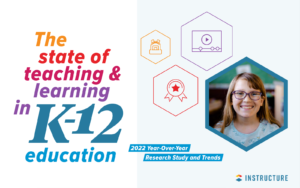SETDA Releases Report On K-12 Infrastructure Needs

State Leaders Stress Importance of Robust Internet Access for Preparation of K-‐12 Students for College, Careers
May 21, 2012 (Washington, D.C.) Today the State Educational Technology Directors Association (SETDA) released The Broadband Imperative: Recommendations to Address K-‐12 Education Infrastructure Needs. This report examines current trends driving the need for more broadband in teaching, learning and school operations; provides state and district examples of the impact of robust deployment of broadband; and offers specific recommendations for the broadband capacity needed to ensure all students have access to the tools and resources they need to be college and career ready. “This information and guidance regarding broadband will assist states in understanding this critical cornerstone for providing equitable access to digital resources, professional development, and a personalized learning landscape,” said Jorea Marple, West Virginia Superintendent of Schools.
Given existing trends and the experiences of leading states and districts, SETDA recommends that schools will need external Internet connections to their Internet service provider of 100 Mbps per 1,000 students and staff by 2014-‐15 and of 1 Gbps per 1,000 students and staff by 2017-‐18. Larry Shumway, Utah State Superintendent of Public Instruction, adds: “Utah supports the use of broadband technology in all of its classrooms. Broadband infrastructure is a vital tools for schools today and will help prepare students for college and careers in the future.”
“Addressing teacher and student concerns regarding educational broadband reliability and speed is as critical as ensuring plumbing and electricity in schools. This report highlights the need for the federal government, states, districts and schools to invest not only in school broadband infrastructure but also more broadly to ensure students can access learning resources both in and out of school,” stated Douglas Levin, Executive Director of SETDA. “Limited access to broadband must not become the stumbling block to helping all
Wisconsin State Superintendent of Schools, Tony Evers, struck a similar theme by noting, “Digital learning offers exciting new opportunities for more personalized learning and student engagement in every classroom….We must move forward quickly to supply sufficient affordable broadband access to every student both in school and at home.”
The Broadband Imperative is a product of collaboration among state educational technology leaders, leading technology companies, and policy and practitioner experts who every day are faced with the challenges of insufficient broadband and witness to the successes of robust access. The numerous examples in the report of successful broadband implementation by states and leading school districts illustrate the power of a fully implemented system.
Maine has long been a leader in leveraging technology for education and realizes the importance of robust broadband access. “Technology and broadband are key to giving students the power to take control of their own learning, and to engage frequently and instantly with learning tools across town and around the world. It’s why the Maine Learning Technology Initiative made high speed Internet at all public schools a requirement,” said Stephen Bowen, Commissioner of Education, Maine Department of Education.
As the report concludes, “Given that bandwidth availability determines which online content, applications, and functionality students and educators will be able to use effectively in the classroom, additional bandwidth will be required in many, if not most, K-‐ 12 districts in this country in the coming years. If we are serious as a nation about preparing all students for college and careers, a concerted national effort will be required to address both school-‐based bandwidth needs and out-‐of-‐school access for students and educators.”
To access the full report, visit: http://www.setda.org/web/guest/broadbandimperative
About the State Educational Technology Directors Association (SETDA)
Founded in 2001, SETDA is the national member association that represents the interests of the educational technology leadership of U.S. state and territorial education agencies in all 50 states, the District of Columbia, and the Bureau of Indian Affairs. SETDA members work collectively and in public-‐private partnerships to ensure that meaningful technology innovations with broad potential for systemic improvements and cost-‐savings in teaching, learning, and leadership are brought to scale. For more information, please visit www.setda.org






Will Herring
Here, Here! In terms of tech in the classrooms, school systems are inevitably forced into a catch-up role because we can never approve or provide “student-safe” versions of popular applications in a timely manner. But, the need for ever increasing bandwidth is a need we can anticipate and should plan accordingly. Regardless of the applications we as educators chose to pursue, our success using them will hinge on our ability to achieve connectivity for ourselves and our students. We have all experienced the headaches of infrastructure being built after it was already needed. Let’s learn from the Department of Transportation and have the super-highway ready for our students in time.
The out-of-school connectivity issue mentioned in the final sentence of the post is a big can of worms to open; but I think we should. I don’t want to assume too much, but I think we can all agree that economically/technologically disadvantaged students face an additional hurdle in the technological age. How can we flip our classrooms if they can’t participate outside the traditional classroom setting? If we consider blended and FT online education a right of students/parents (as it is in some states as part of a parental choice program), than shouldn’t we simultaneously consider issues of connectivity at students’ homes a right? We don’t want connectivity to become the new front in education’s civil rights problem. Is it already?
Will Herring, Dr. Setser’s Summer ECI 509 class member